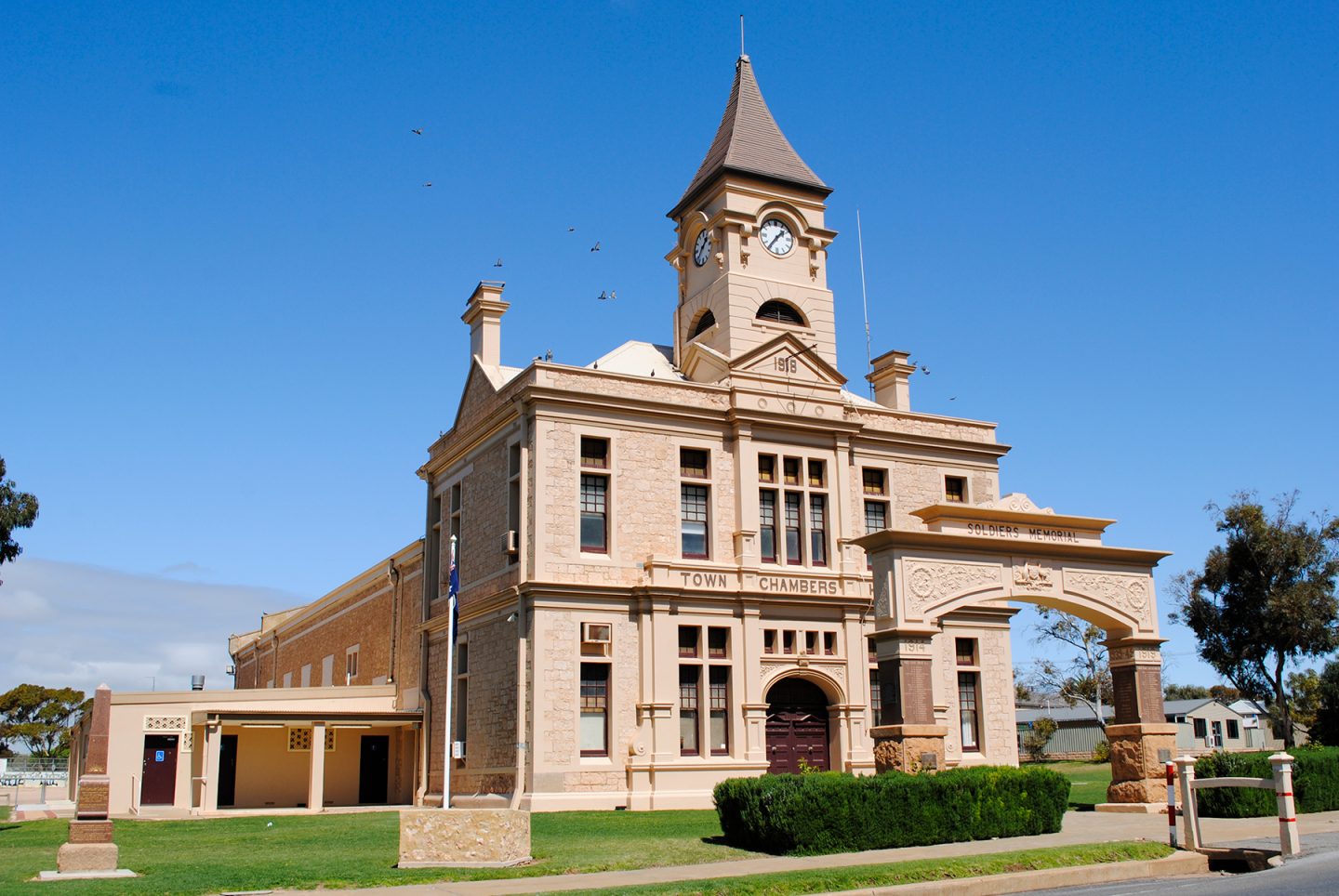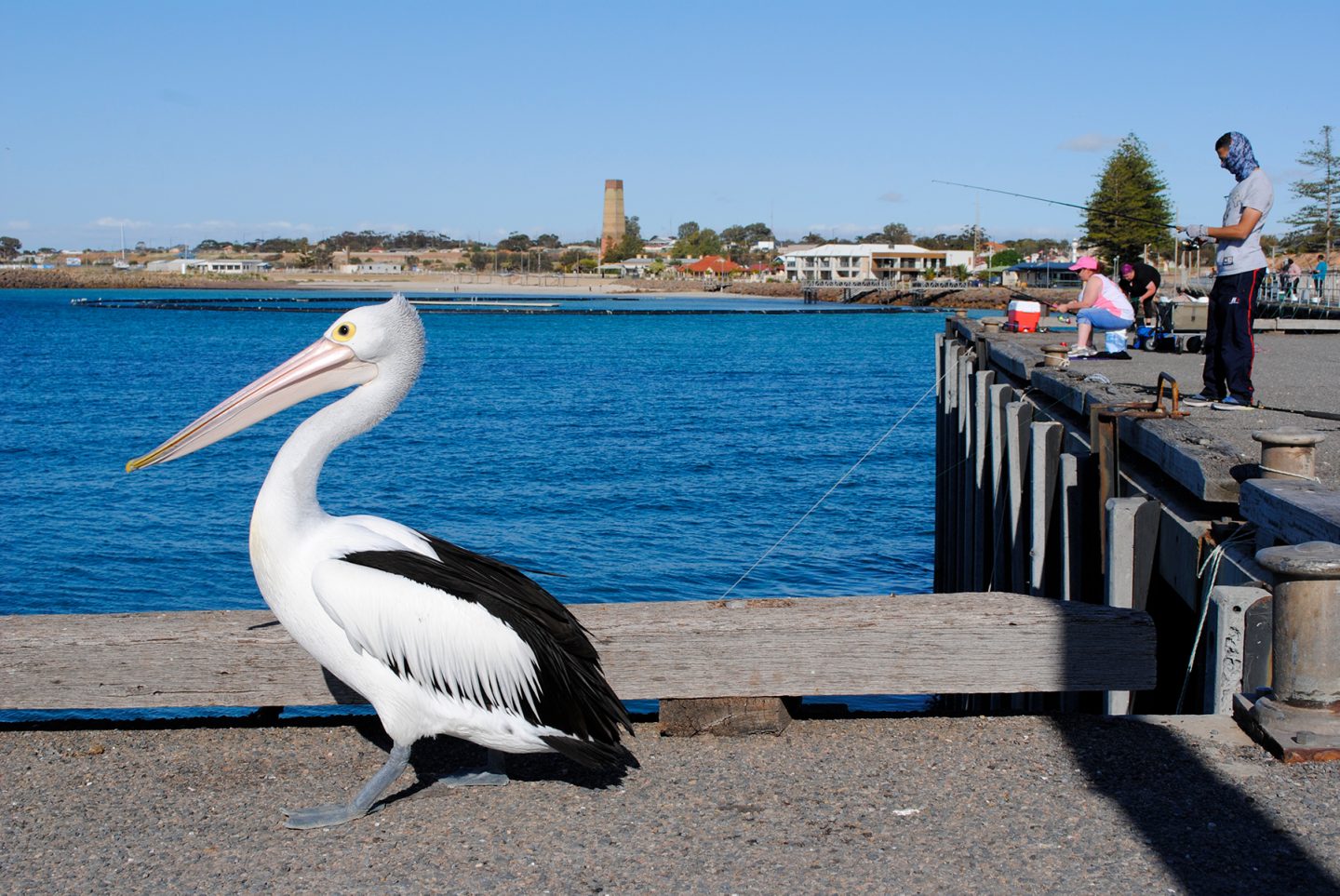Nearby Moonta retains
a distinctly Cornish flavour, but Wallaroo reveals traces of the largely Welsh
immigrants who made copper smelting such a success from 1862 to 1923. Some of
Wallaroo’s early buildings demonstrate the Welsh style, being symmetrical,
close to the road and without a verandah. The one remaining smelter chimney has
sides and corners, whereas Moonta’s old chimneys are round, as the Cornish
believed that the devil hides in corners. At one time, it was common to hear Welsh
spoken in Wallaroo.
Long-time resident
Gwynffa Thompson has a Welsh given name. Her maternal ancestors travelled from
Wales to work at the smelter in 1864. Her parents left the town but came back
with Gwynffa in 1944. She too eventually left, to work as a nurse, but returned
and retired in Wallaroo 13 years ago.
 Wallaroo Town Hall
Wallaroo Town Hall
Gwynffa says, “I came
up here thinking I could fit in, but it’s not easy to join clubs in the
country, especially as I’m not sporty. But the city was getting busier and
busier.”
Ironically, Gwynffa
returned to a Wallaroo that has also continued to get busier. She and friend
Fay McKee (one of whose children Gwynffa delivered) aren’t big fans of the
changes to their hometown. Says Fay, “I love Wallaroo, but I don’t like change.
I don’t like how all the old buildings have changed.”
Yet the tide of change
continues to advance, with extensive housing development, stylish eateries
(yes, The Smelter café, I’m looking at you), the lavishly stocked Foodland
(where the friendly employees have a quaint habit of saying “Right here” when
serving the next customer) and multicultural tourists.
Wallaroo’s life force
is the jetty. At its base are two restaurants and the Wateroo, a safe enclosure
for swimming. The jetty’s long enough to accommodate the many people who
gravitate there (particularly in months with ‘r’ in them, which, as any fisho
will attest, are the best months for crabbing). The far end of the jetty is
where large ships load grain from the looming Viterra grain terminal via an
enormous conveyor belt over the ocean. This enabler of industry lends an
appealing surrealism to an already lovely seascape.
It’s pleasant to feel
the cold salty water on your hands from a rope, and the splash on your arms and
face as you haul up a drop net with hope (and excitement if the net c ontains a
good-sized bluey). A quick stroll along the jetty confirms that fellow fishos
share such delights. For example, Federico Areola brought his wife, daughter
and sons to Wallaroo, and they’re all having a go. Says Federico, “First time
we come here. My friend said to come here, but we caught nothing. Only crabs. I
bought a $300 fishing rod, and something pulled it in the side, and I’m trying
to use my squid jig [on a hand reel] to get it.”
 A pelican by the waterfront at Wallaroo
A pelican by the waterfront at Wallaroo
Moving on. Another
punter, Lewis Cantone, says of Wallaroo, “It’s bloody beautiful. Been coming
here for 25 years. Always go crabbing and fishing. I got 30 or 40 crabs one
night … between six of us, I mean.”
Someone who can
outshine Cantone (and friends) is Irina Zelenskaya, formerly of Kazakhstan: she
and her partner once caught 28 crabs in one day and night. But Wallaroo means
more to her than this,: on a magical New Year’s Eve, her partner turned himself
into a fiancé, and the happy couple spent the rest of New Year’s watching
fireworks at the Wallaroo country fair, dazed with love and cinnamon doughnuts.
Wallaroo has been home to Australians of national significance:
Caroline Carleton, lyricist for The Song of
Australia, and AFL footy great Adam Goodes. Although Carleton is recognised
in monuments, signs and walking tours around the town, Goodes, who was born in
Wallaroo, isn’t. This needs fixing. It’s apt to honour such an admirable man,
whose people, the Narungga, are the traditional owners of the land that’s
brought prosperity and pleasure to so many visitors.
Get the latest from The Adelaide Review in your inbox
Get the latest from The Adelaide Review in your inbox